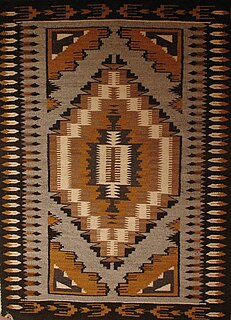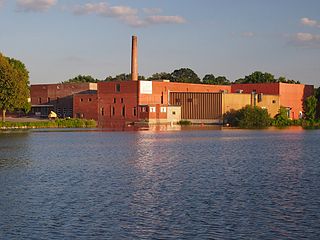Related Research Articles

A textile is a flexible material made by creating an interlocking network of yarns or threads, which are produced by spinning raw fibres into long and twisted lengths. Textiles are then formed by weaving, knitting, crocheting, knotting, tatting, felting, bonding, or braiding these yarns together.

Uxbridge is a town in Worcester County, Massachusetts first colonized in 1662 and incorporated in 1727. It was originally part of the town of Mendon, and named for the Earl of Uxbridge. The town is located 36 mi (58 km) southwest of Boston and 15 mi (24 km) south-southeast of Worcester, at the midpoint of the Blackstone Valley National Historic Park. Uxbridge was a prominent Textile center in the American Industrial Revolution. Two local Quakers served as national leaders in the American anti-slavery movement. Uxbridge "weaves a tapestry of early America".
Woolen or woollen is a type of yarn made from carded wool. Woolen yarn is soft, light, stretchy, and full of air. It is thus a good insulator, and makes a good knitting yarn. Woolen yarn is in contrast to worsted yarn, in which the fibers are combed to lie parallel rather than carded, producing a hard, strong yarn.

Poplin, also called tabinet, is a fine, but thick, wool, cotton or silk fabric that has a horizontal warp and a vertical weft. Nowadays, it is a strong fabric in a plain weave of any fiber or blend, with crosswise ribs that typically gives a corded surface.

Cashmere wool, usually simply known as cashmere, is a fiber obtained from cashmere goats, pashmina goats, and some other breeds of goat. It has been used to make yarn, textiles and clothing for hundreds of years. Cashmere is closely associated with the Kashmir shawl, the word "cashmere" deriving from an anglicisation of Kashmir when the Kashmir shawl reached Europe in the 19th century from Colonial India. Common usage defines the fiber as wool, but it is finer, stronger, lighter, softer and approximately three times more insulating than sheep wool. Both the soft undercoat and the guard hairs may be used; the softer hair is reserved for textiles, while the coarse guard hair is used for brushes and other non-apparel purposes.

Pumpernickel is a typically heavy, slightly sweet rye bread traditionally made with sourdough starter and coarsely ground rye. It is often made today with a combination of flour made from rye as well as whole rye grains.

A blanket is a piece of soft cloth large enough either to cover or to enfold a great portion of the user's body. It is usually used when a person goes to sleep or is otherwise at rest. It traps radiant bodily heat that otherwise would be lost through convection, helping to keep the user warm. Many children and adults use a blanket as a comfort object.

A poncho is an outer garment designed to keep the body warm. A rain poncho is made from a watertight material designed to keep the body dry from the rain. Ponchos have been used by the Native American peoples of the Andes and Patagonia since pre-Hispanic time, from places now under the territory of Ecuador, Colombia, Chile, Bolivia, Peru, and Argentina and are now considered typical South American garments.

A chipolata is a type of fresh sausage, likely created in France. Sausages by that name appear in the 1903 edition of Escoffier's Le guide culinaire. Chipolatas are often prepared as a relatively thin and short sausage.

A Hudson's Bay point blanket is a type of wool blanket traded by the Hudson's Bay Company (HBC) in British North America and the United States during the 1700s and 1800s. The company is named for Hudson Bay and the blankets were typically traded to First Nations in exchange for beaver pelts. The blankets continue to be sold by Canada's Hudson's Bay stores and have come to hold iconic status in Canada. In the United States, they can be found at the luxury department store and Hudson's Bay former sister chain Lord & Taylor.
Pendleton Woolen Mills is an American textile manufacturing company based in Portland, Oregon, United States. It is known for its blankets and woolen clothing.

Broadcloth is a dense, plain woven cloth, historically made of wool. The defining characteristic of broadcloth is not its finished width but the fact that it was woven much wider and then heavily milled in order to shrink it to the required width. The effect of the milling process is to draw the yarns much closer together than could be achieved in the loom and allow the individual fibres of the wool to bind together in a felting process, which results in a dense, blind face cloth with a stiff drape which is highly weather-resistant, hard wearing and capable of taking a cut edge without the need for being hemmed.
The manufacture of textiles is one of the oldest of human technologies. To make textiles, the first requirement is a source of fibre from which a yarn can be made, primarily by spinning. The yarn is processed by knitting or weaving, which turns yarn into cloth. The machine used for weaving is the loom. For decoration, the process of colouring yarn or the finished material is dyeing. For more information of the various steps, see textile manufacturing.
Kerseymere is a fine woolen cloth with a fancy twill weave. In printing fine work during the mid-19th century, the blankets that lay between the tympans were either fine kerseymere or superfine woolen cloth.

Navajo rugs and blankets are textiles produced by Navajo people of the Four Corners area of the United States. Navajo textiles are highly regarded and have been sought after as trade items for over 150 years. Commercial production of handwoven blankets and rugs has been an important element of the Navajo economy. As one expert expresses it, "Classic Navajo serapes at their finest equal the delicacy and sophistication of any pre-mechanical loom-woven textile in the world."

Cameline was a fabric material used in the Middle Ages for cloth. By tradition it is commonly thought to have been originally made of camel's hair in Asia. It was imported from Cyprus and Syria into Europe. Cameline is described also as a cloak of the Arabs made of camel's hair which is oftentimes striped white and brown in color. Since history records it many times as a "common and cheap" textile it is thought that it was an imitation of the original Asian camel's hair fabric. It was sometimes a lower quality French cloth imitation made of goat's hair. The fibers were spun into yarn and produced in Flanders and the Duchy of Brabant in many colors in medieval times. It is also described as a warm light woolen textile of camel's hair combined with wool or cotton. It is considered of lesser quality than that of camlet, which is also made of camel's hair.

The Faribault Woolen Mill Company is a textile manufacturing company in Faribault, Minnesota, United States, that produces and sells wool blankets and other woolen products. Its products included ingeo, cotton, acrylic and wool bed blankets, pillows, mattresses, pads, and baby blankets, and wool, ingeo and blend throws. The company primarily serves various enterprise sectors. It offers its products through its store in Faribault and nationwide through retailers.

The Hilgen and Wittenberg Woolen Mill is a former textile factory in Cedarburg, Wisconsin. Built in 1864, the mill was one of many wool- and flax-processing factories that opened during the American Civil War, due to a shortage of cotton textiles formerly supplied by southern states. The mill produced yarns, blankets, and flannels, and was the largest woolen mill west of Philadelphia in the 19th century. The mill closed in 1968 and has since become a commercial complex called the "Cedar Creek Settlement," containing restaurants and stores.
Vegetable flannel is a type of flannel using fibres from the Scots pine, or Pinus sylvestris, rather than traditional woollen fibres. It is described as having a hemp-like appearance, but with a tighter, softer texture. In addition to this, the term can also describe coarse linen used for underclothing.
Ratteen (Ratine) was a thick napped twilled woolen material. Ratteen was produced in France, Italy and Holand.
References
- ↑ New York State Library. New York State Education Department. 1908. p. 11.
- ↑ Blakely, Edward T. (1878). A Handy Dictionary of Commercial Information. Simpkin, Marshall. p. 14.
- ↑ Whitney, William Dwight (1889). The Century Dictionary: An Encyclopedic Lexicon of the English Language. Century Company. p. 191.
- ↑ New York State Library. New York State Education Department. 1908. p. 796.
- 1 2 Montgomery, Florence M. (1984). Textiles in America 1650-1870 : a dictionary based on original documents, prints and paintings, commercial records, American merchants' papers, shopkeepers' advertisements, and pattern books with original swatches of cloth. Internet Archive. New York ; London : Norton. p. 145. ISBN 978-0-393-01703-8.